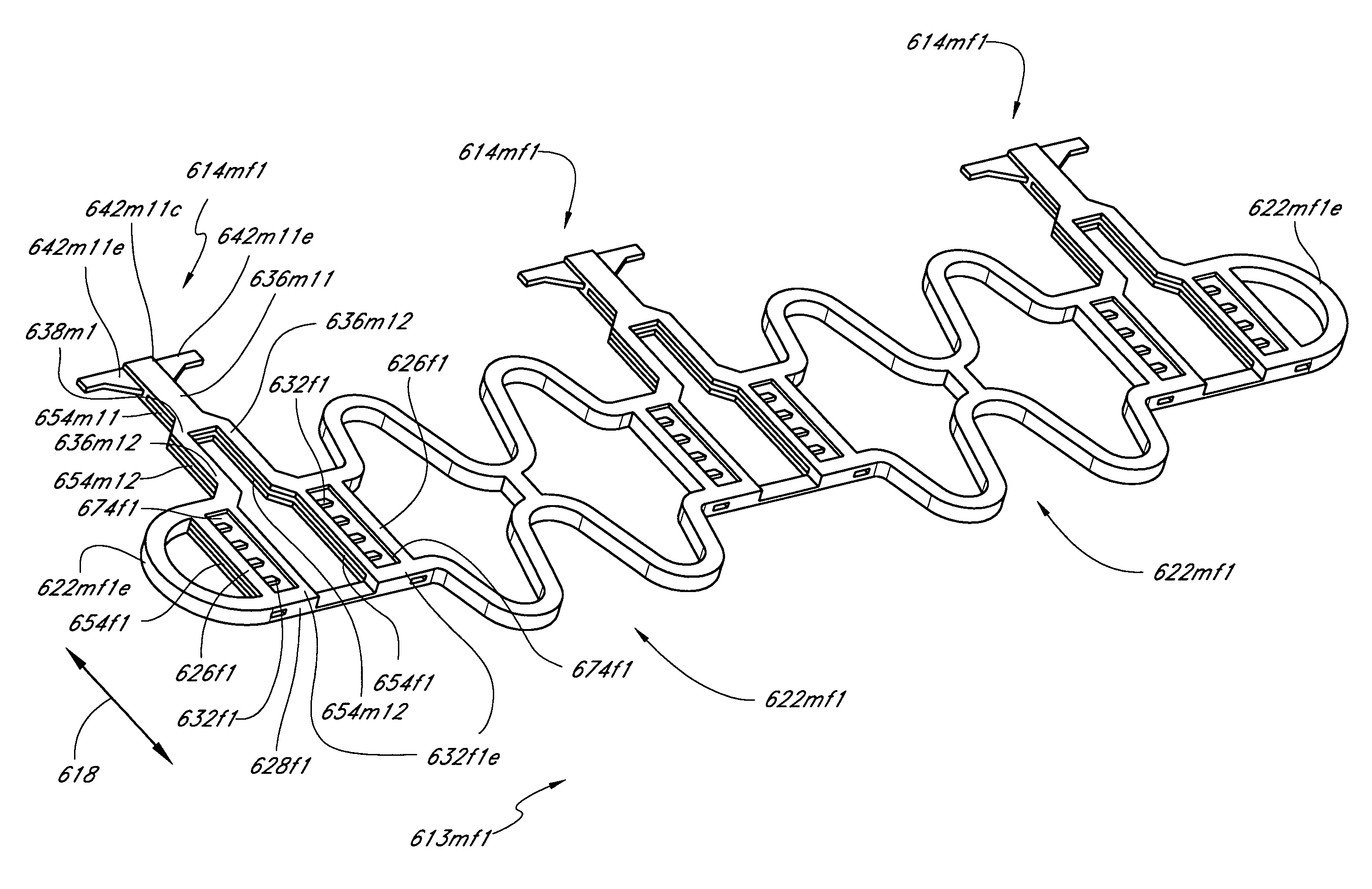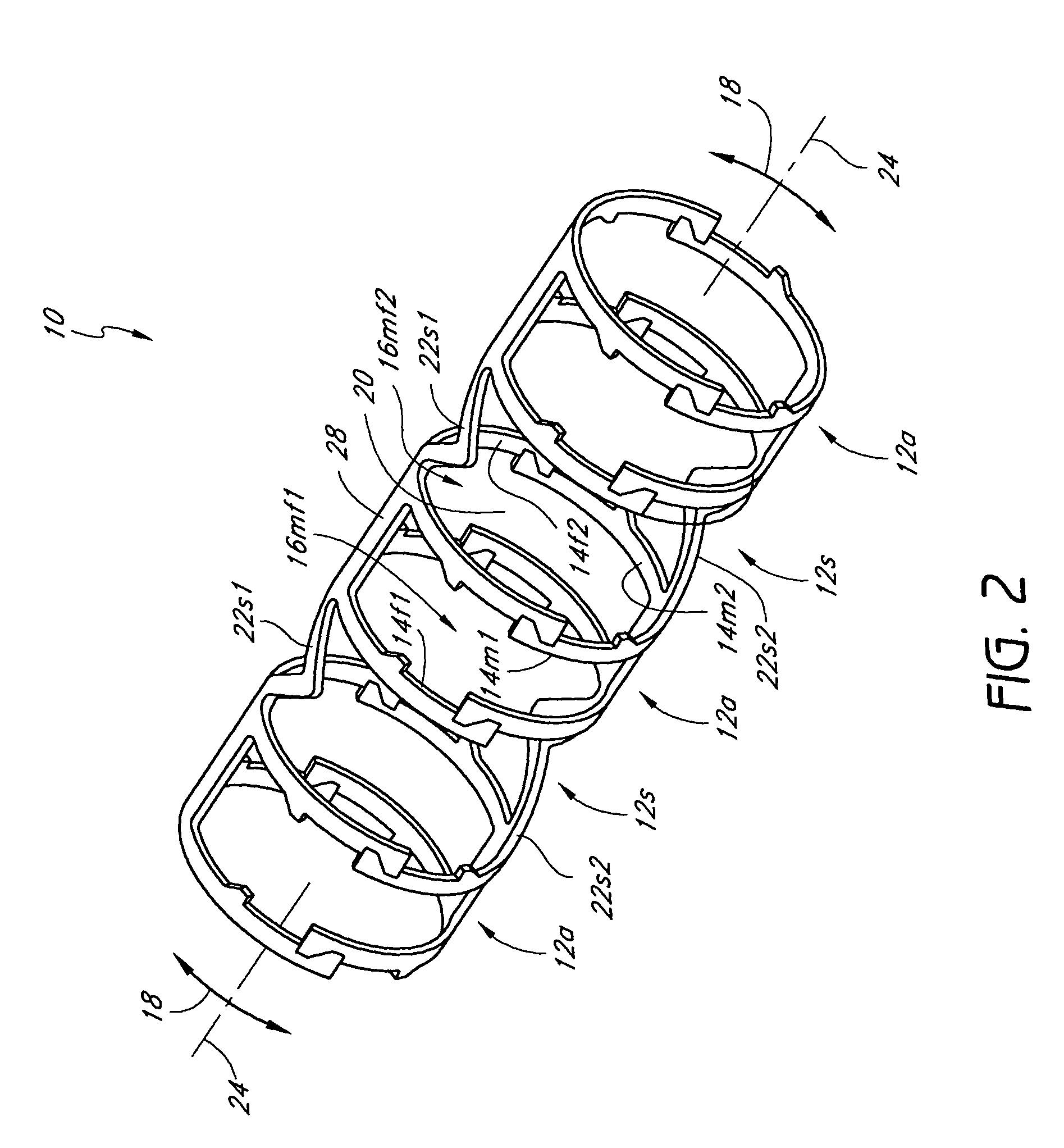[0022]During manufacture and assembly of the axially nested embodiments, the device structural elements are substantially majorly or primarily positioned side by side (axially) in the predilated or non-expanded state to substantially reduce or minimize the device crossing profile and bulk in both the undeployed (non-expanded, predilated) and deployed (expanded, dilated) states. Advantageously, by substantially reducing or eliminating the excess bulk typically encountered with a radially nesting device design, embodiments of the invention can be used to achieve competitive devices and crossing profiles with a wide variety of materials at a wide variety of thicknesses, thereby desirably allowing for optimum device design and performance.
[0023]Many conventional slide and lock vascular devices comprise elements that overlap each other in the radial direction, i.e., lay upon each other. This feature can limit that thickness of material that can be employed as well as the number of elements that can be employed. As the thickness or element number increases, competitive features of the device may be compromised, such as crossing profile. To provide acceptable crossing profiles, the thicknesses and the number of elements employed in these radially nesting devices is often reduced, which can have an impact on such features as reliability and device radial strength.
[0029]Some embodiments provide a slide-and-lock stent that comprises a tubular member. The tubular member is expandable from a first diameter to a second diameter. The tubular member comprises a first circumferential section and a second circumferential section. The circumferential sections are longitudinally arranged. A linkage section connects the circumferential sections and is configured to provide flexibility. Each of the circumferential sections comprises a first slide-and-lock element and a second slide-and-lock element. The corresponding slide-and-lock elements of each circumferential section are radially connected by a slidable articulating mechanism. Each of the first slide-and-lock elements comprises at least one tooth and each of the second slide-and-lock elements comprises at least one radially extending tooth. During expansion the teeth of the first slide-and-lock elements engage corresponding radially extending teeth of the second slide and lock sections. The teeth are configured to permit one-way sliding between the corresponding first and second slide-and-lock elements such that at least a portion of the corresponding first and second slide-and-lock elements is radially deflected during expansion from the first diameter to the second diameter.
[0030]Some embodiments provide a slide-and-lock stent that comprises a tubular member. The tubular member is expandable from a collapsed state to an expanded state and comprises a lumen. The tubular member comprises at least one slide-and-lock section. The slide-and-lock section comprises at least one first structural element and at least one second structural element that are radially interlocked with an articulating mechanism such as to provide circumferential relative motion between the first structural element and the second structural element. The articulating mechanism is configured to permit one-way sliding between the first structural element and the second structural element such that at least a portion of the first structural element and / or at least a portion of the second structural element is elastically deflected during expansion from the collapsed state to the expanded state. Advantageously, the radial interlocking between the structural elements substantially eliminates radial overlap and allows for a substantially clear through-lumen such that substantially no structure protrudes into the lumen in either the collapsed or the expanded state.
[0032]Embodiments of the invention provide an improved stent: one that desirably is small enough and flexible enough when collapsed to permit uncomplicated delivery to the affected area; one that is sufficiently flexible upon deployment to conform to the shape of the affected body lumen; one that expands uniformly to a desired diameter, without change in length; one that maintains the expanded size, without significant recoil; one that has sufficient scaffolding to provide a clear through-lumen; one that supports endothelialization or covering of the stent with vessel lining, which in turn minimizes the risk of thrombosis; and one that has a greater capacity to deliver therapeutic agents to minimize injury, treat restenosis and other vascular diseases.
[0039]One key design aspect of embodiments of a slide and lock vascular device is its deployment ratio, that is, the ratio of final maximum diameter to initial compacted diameter. Depending upon the particular design being pursued or the application being addressed, the deployment ratio may vary. Advantageously, the stent of embodiments of the invention allows the number of elements to be increased or decreased, that is, varied, as needed or desired, to achieve optimization of the deployment ratio as well as device performance, crossing profile, flexibility, among others. This desirably adds to the device versatility and utility.
 Login to View More
Login to View More 


